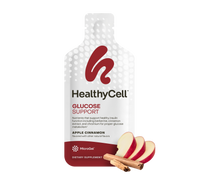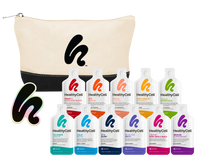Article at a glance
- Gummy vitamins are sweet treats that adults love to take, but are they actually good for us?
- Discover the top 3 benefits and 4 major drawbacks of gummies for adults.
- A new, tasty alternative that touts all the benefits of gummies without the drawbacks.
Ah, to be a kid again, when our biggest problem involved coloring inside the lines, and naps were still a part of the curriculum (who decided naptime should stop after grade school anyway?). But one thing that hasn't changed since we were kids? We don't always eat our fruits and vegetables, and even if we do, we're still not likely to meet all of our nutrient needs. Because of this, we've had to step up our nutrition game with vitamin supplementation to meet our micronutrient minimums.
As kids, we collected baseball cards and stickers. As adults? Most of us collect pills, much to our dismay. From liquids to powders and even patches, most of us will try just about anything to avoid choking down another tablet. But there's one form of multivitamin that caters to both our anti-pill preference and our inner-child: the gummy vitamin.
As the gumption for adult gummy vitamins grows, more questions arise as to whether or not these vitamins are as good for our health as they claim. Is there any real advantage for taking these vitamin treats? How do they stack up against the old fashioned pills and tablets? It's time we get some closure on gummy vitamins, once and for all.
The Benefits of Gummy Vitamins for Adults

Great Tasting
Let's face it; many of us require a multivitamin because we simply don't get enough fruits, vegetables, and other healthy foods in our diet. The reason? These foods aren't as appealing as the bounty of sugary, salty, processed snacks that are all-too-accessible at any given moment.
As you roam down the grocery aisles, shopping basket swinging on your arm, you're more likely to toss in items that you know you'll eat because, frankly, they taste good! So as you sashay right past the celery and into the snack section of the store, we can take a guess why you'll grab for a gummy vitamin (and why you might need a multivitamin in the first place).
Gummy vitamins give you that delicious immediate gratification you’re looking for. They taste like something you'd find at a movie theatre concession stand but claim to provide the same health benefits as something you'd find at a produce stand. It's obvious why picky palates would gravitate towards a fun and tasty gummy vitamin rather than a bitter pill, unpleasant powder, or a vile liquid.
Easier to take and to stick with
We've all been there: we told ourselves that we're going to focus on our health and stick with a consistent supplement schedule. We stock up with every vitamin pill and powder we can get our hands on and even designate a spot on the counter for these bottles of health. After all of the effort, there's no way we can fall off our vitamin routine!
Until we do. Maybe we stick with it for a few weeks or perhaps just a few days, but eventually, most of us lose our multivitamin motivation. Let's face it, choking down a chalky pill every day is just not enjoyable. So when you compare the standard horse pill to a candy-like gummy, there's no contest – we are more likely to keep up with our daily gummy vitamin than with a tablet.
The trouble with compliance is a primary reason why consumers don't enjoy the full benefits of their vitamin routine. Many Americans report having difficulty with pills thanks to the size, texture, and shape, so it's easy to see why gummy's appeal to adults and children alike.[2]
Gummy vitamins come in a variety of fun, chewable shapes, and flavors that are as easy to eat as they are enjoyable. So while many of us will "forget" to take our massive multivitamin pill, we're far less likely to forget our fruity vitamin chews.
Lower price tag
As Americans continue to grab for gummy vitamins over pills, there's been a supplement showdown as the market saturates with candy-like vitamin competition.[3] This race for gummy gold within the multivitamin category is excellent for consumers since brands have to keep their prices competitive as they try to satisfy America's supplement sweet tooth. As demand continues to grow for gummies, multivitamin companies are scrambling to produce more variety of sugary chews at a lower cost, hoping to seduce the shopper browsing the supplement aisle to find the tastiest and most cost-effective gummy vitamin they can get their hands on.[4]
Gummy Vitamin Drawbacks

A gummy gamble with vitamin dosing
Gummy vitamins very rarely contain the correct concentrations of vitamins and minerals.[5] With 80% of gummy vitamins testing at levels that were higher or lower than stated on the label, consumers are left taking a sweet shot in the dark with their micronutrient intake. Ultimately, this can either lead them further down a rabbit hole of vitamin deficiency or worse yet, with harmful health repercussions that come with excessive vitamin intake.[6]
Why is this? The FDA does not regulate gummy vitamins or most supplements for that matter. They make recommendations. This means companies can add whatever ingredients they want without having to undergo regulation processes that would determine if the ingredients, combinations, and the amounts were safe or not.
On top of dosing issues, operator error is another factor that puts vitamin takers at risk. We're far more likely to sneak an extra vitamin or two when that supplement comes in the form of a sweet gummy. Gummy multivitamins offer the perfect excuse to include "candy" into our diets when we may have tried to cut back on the real stuff. As such, gummy vitamins become all the more appealing by giving us the perfect way to satisfy our sweet tooth under the guise of boosting our micronutrient intake. It then becomes all too easy to gravitate to these gummies whenever a sugar craving strikes. Over time, this means of satisfying our sweet tooth can lead to compromised health due to vitamin toxicity. Not exactly the results we were aiming for by taking a multivitamin.
Sweet, but short (on essential nutrients)
When we take a closer look at some of the leading gummy vitamin brands, almost every product failed to provide the entire array of essential vitamins and minerals, lacking anywhere from 8 to 11 of these key micronutrients. Our body requires at least 30 vitamins, minerals, and other vital nutrients that are essential for maintaining our health.[7] The goal of vitamin and mineral supplementation is to fill the nutritional gaps that arise from an incomplete diet. Since the human body can't generate many of these micronutrients on its own, we have to rely on food sources and supplementation to ensure that we maintain adequate levels for our wellbeing. Again, this is another area where gummy vitamins fall short.
Since most gummy multivitamins don't provide the full spectrum of vitamins and minerals, often leaving out necessary nutrients like vitamin K and magnesium, it begs the question, why take a nutritional supplement that you'd have to supplement?
There are a few factors that have placed brands between a rock and a hard spot when it comes to creating a complete gummy multivitamin. Many vitamins and minerals have a distinct taste that's hard to mask, even when it's been sugar-coated, forcing companies to limit the amounts they add or even leave them out altogether. Minerals are particularly challenging for gummy vitamin makers because some have an off-putting, metallic taste.[8]
Lower Absorption
While far less delicious, other forms of vitamins do "one-up" gummy's in one significant way: vitamin bioavailability. Yes, the sugary chew may be fun to eat, but it doesn’t compare to other vitamin delivery methods, particularly with that of liquid vitamins.
As soon as we begin to chew these sweets, we begin the breakdown and digestion process. Thanks to the enzyme amylase, which is a chemical present in our saliva that digests carbohydrates, our body makes fast work of breaking down these sweet supplements.[11] By the time the gummy reaches the stomach, where its subject to more digestive enzymes and high acidity, the gummy vitamin has been almost entirely degraded.
Without the protection of a capsule or tablet, the micronutrients in the gummy vitamin are unable to make it to the small intestine, where the majority of absorption occurs during digestion.[12,13] So we're left absorbing less bioactive form of the vitamins compared to other supplement forms. When you consider that a gummy already provides fewer vitamins and minerals than traditional supplements, this becomes particularly problematic. So while the pill form may not be as fun, they are more functional than these sugary supplement alternatives.
Sugars, fillers, and colors (oh my!)
They look like candy, taste like candy, smell like candy, but they're healthy, right? While gummy vitamins may come with a boost of micronutrients added to the mix, a closer look at the ingredient label reveals a striking resemblance to the likes of Sour Patch Kids. So what are these non-essential "other" ingredients that accompany the essential vitamins and minerals?
Sugars, sweeteners, and sugar alcohols: There's a good reason why these sweet supplements appeal to adults and children alike: they taste like something Willy Wonka himself whipped up. With 1-2 grams of sugar per gummy, the nutrition label for these vitamin sweets isn't far off from many of America's favorite candy treats. From sticking to your pearly whites to tipping your weight upward on the scale, over time, these extra carbs can negatively impact your health.[14]
The sugar and high fructose corn syrup added to gummy vitamins work as both a sweetener and a way to mask the unpleasant taste of certain minerals. However, while these sweeteners result in a tastier supplement, our body will treat a gummy vitamin as it would any other simple carbohydrate, breaking it down rapidly while spiking our blood sugar.
If a brand does choose to skip the sugars or sweeteners, they typically rely on sugar alcohols, which give the sensation of sweetness without the caloric consequence. The problem with these alcohols is that they wreak havoc on many peoples’ digestive system, leading to symptoms like diarrhea, gas, nausea, and bloating.[15] If a supplement is sticking to your teeth, thickening your hips, or making you feel sick, it sounds like it's doing more harm than good.
Fillers: These ingredients are used to bind and bulk up gummy vitamins to reach a candy-like, thick consistency. Two common culprits you might find on the label are carrageenan, a thickening agent, and gelatin, a binding agent.
If you follow a vegan or vegetarian diet, the addition of gelatin to gummy vitamins is a plant-based problem as this ingredient is sourced from the tendons, ligaments, and bones of cows or pigs.[16] Unfortunately, the source of gelatin is not the only issue with this dodgy additive, which has been linked to digestive distress for many consumers.
Carrageenan, on the other hand, is a common food additive that is derived from red seaweed and is added to gummy vitamins as a vegan alternative to gelatin and other forms of thickening agents. While this filler might be cruelty-free, it's certainly not risk-free when it comes to our health. Research has shown a link between carrageenan and an increased risk of developing both cancer and gastrointestinal ulcerations.[17] Not exactly the sweet side effect you'd expect from a supplement.[17]
Artificial Colors: They say you first eat with your eyes, which is why some manufacturers of gummy multivitamins add artificial colors to their products. The visual appeal of these brightly colored vitamins is much more enticing than the colorless, murky white or brown alternatives. However, when you weigh the risks associated with artificial food coloring, an ugly gummy doesn't seem like such a bad option.
Red 40, Yellow 5, and Yellow 6 are three dyes that commonly sneak into gummy supplements. These dyes all contain benzidine, a known carcinogen, that may lead to increased anxiety, migraines, and behavioral changes. [18,19]
It's easy to be seduced by the sweet satisfaction of a daily gummy, which might make it difficult to remember the original reason we take our multivitamin in the first place (to promote our health).
If you've found yourself in a sugar-coated quandary with a distaste for multivitamin pills and a distrust for gummy's, read on for a welcome alternative for anyone who's looking to upgrade their supplement routine without compromising the health benefits.
A new, better alternative: Gels

The Benefits of Gummies, With The Drawbacks
We've given a side-eye to the sweetest supplement to hit the shelves, but it seems that going from pills to gummies and back to pills once more would be hard to do. Whether you’re selecting gummy or pill-based vitamins, the bottom line is most of them individually are not effective at supplementing your diet. In many cases, you’d have to take 10 or more different gummies or pills equal to what can be delivered in a microgel version.
Luckily, Healthycell is changing the way people take vitamins in a new pill-free way that can be just as fun as taking gummies with the introduction of the gel, or more specifically, the MICROGEL™. Microgel is the next-generation nutrient delivery technology replacing tablets, capsules, powders, and gummies.
Formulated by world-leading physicians and nutritional scientists, this unique microgel technology allows for maximum absorption of ingredients into the body by releasing extremely small, ultra-bioavailable nutrient particles at specific locations in the digestive tract.
The first product launched with this technology is Bioactive Multi, a broad spectrum of essential vitamins, minerals, antioxidants, polyphenols, and prebiotics to ensure a foundation for wellbeing. It’s served up free of the high fructose corn syrup and high amounts of processed sugar found in gummies. It’s a more natural approach all around, eliminating the need for synthetic binding glues, fillers, coatings, and anti-caking agents listed as "other ingredients" in many supplements.
Bioactive Multi by Healthycell is a leader in the microgel multivitamin category and has pushed past the limits of pill vitamins without succumbing to the sweet gummy supplement scene. By creating a product that accounts for the well being of the consumer while still offering a pill-free tastier supplement, it is the best option on the market right now.
The Bioactive Multi microgel can be added to just about any meal or snack. Mix it into smoothies and oatmeal, or drizzle it on as a glaze for snacks like toast and rice cakes; the options are endless. And if you don't have time to play master chef with your microgel, shoot it back for a super quick, supercharged boost on the go!
If you're vegan or plant-based, try our Vegan Essentials microgel with 30+ vitamins, minerals, and other nutrients essential to a plant-based diet.
In addition to their Daily Essential Multivitamins, Healthycell also makes microgels targeted for sleep, focus and immune support. REM Sleep supports all 4 stages of sleep so that you can fall asleep easier, stay asleep, sleep deep, and wake up refreshed. The Focus + Recall formula boosts short-term focus and long-term brain health. Immune Super Boost combines 15 full doses of immune boosting ingredients in one gel pack.
From the outside, it's not hard to see why kids and grownups alike have gone gangbusters for gummy vitamins. But with a daunting list of drawbacks, is this vitamin treat really just a trick? We think it's time to say game over gummy's. We're ready for microgels to mix up the multivitamin aisle!
Shop our best-selling gel vitamins for more Healthycell products.




